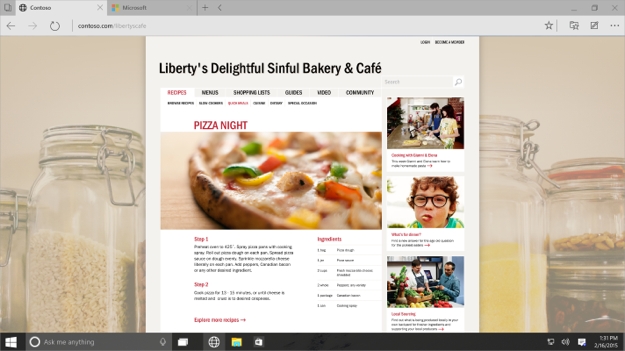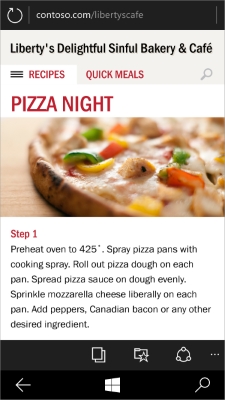What Does the Demise of Internet Explorer Mean for the Future of Website Design?
May 2015
By Jeremy Girard

On January 21, 2015, web developers everywhere let out a great collective sigh of relief. Why? Because that was the day Microsoft announced that Windows 10 will ship with a brand new browser, code-named
“Project Spartan,” thus effectively signaling the inevitable demise of the old stalwart Internet Explorer.
According to Microsoft, Spartan is designed to provide a more interoperable and reliable experience with advanced features including the ability to annotate web pages, a distraction-free reading experience and integration of Cortana for finding and doing things online faster.


While this all might sound appealing to the average user, it is particularly welcome news for web developers, for whom Internet Explorer has long been regarded as the very bane of their existence. You see, each browser interprets code in different ways, and each has different versions that offer different capabilities. While Chrome, Firefox and Safari do have their differences, for the most part they have the same capabilities. However, Internet Explorer, or IE, has historically been the odd one out, notorious for causing issues for website designers due to its lack of capabilities, especially in older versions like IE7 and IE8 (which, for example, does not support such simple design elements as rounded corners and text shadows).
But while web devs are raising their glasses to toast IE’s impending downfall, you’re probably left with more than a few questions. After all, since IE has been the standard Windows browser since the mid-1990s, that little blue “e” icon has become synonymous with the Internet for many everyday users. So what exactly does Microsoft’s decision to do away with Internet Explorer mean for you – and most importantly – for your website? Let’s explore (no pun intended).
The challenges of IE
On today’s Web, the various browser manufacturers have agreed on a certain set of standards that they will all obey. This is incredibly important for web designers (and, by extension, for businesses that have websites), because it means that as long as your website conforms to those agreed upon standards, it should be displayed in a fairly consistent manner no matter which browser a visitor uses to access your site. Unfortunately, this is not always the case.
In the mid-to-late 1990’s, Microsoft was engaged in a heated race for market share with the other most popular browser of the day, Netscape Navigator. Instead of agreeing on a singular set of standards, these two companies tried to outdo each other by adding proprietary features to their software that would interpret and display websites differently. This created a lose-lose scenario for web designers and businesses, as it meant that you either had to develop two different versions of your site (one for each popular browser) or dictate which browser visitors should use (this is why it became commonplace to see disclaimers on sites reading something like “Best viewed in Internet Explorer 4”). This exclusive approach is what led some companies to build the software they use to run their business for those specific platforms. Even now, almost 20 years later, companies that continue to use that software may still be dictating that their employees must use a woefully outdated browser. This is where IE begin to falter, especially in the court of public opinion.
As newer browsers, such as Google’s Chrome – which now ranks as the most popular according to many studies – began to enter the market, people started using them at home. They quickly discovered that these modern browsers were not only much faster but that they also included many new features and capabilities. It didn’t take long for consumers to develop a strong preference for these newer browsers and to begin pushing back against their IT departments’ requirements that were keeping them shackled to antiquated versions of IE at the office.
Microsoft realizes the problem
You might think that Microsoft would love any scenario in which people are forced to use their browser. On the contrary, however, it has created a major PR problem for them. The same IT departments that would not allow employees make the switch to a new browser also prevented them from upgrading to newer versions of Internet Explorer.
The reality is that those new versions of IE are very capable browsers that, like the others on the market today, conform to the standards that are an important part of modern web design. Microsoft wants customers to begin using these new versions of their software because the continued use of versions that were originally released 10 years ago or more has created a vey negative perception of their product in the marketplace that has tainted the Internet Explorer brand as a whole.
The struggles of web designers
While old versions of web browsers certainly pose problems for consumers, they are doubly challenging for web designers and for the companies they build sites for. Testing newly developed websites in legacy browsers to ensure reliable backwards compatibility is a critical step in the process that requires significant time and effort, creating overhead that adds to the timeline and budget of every project.
Exactly how many people are visiting your site with those outdated browsers? It depends on the nature of your business. For instance, my company works primarily with IT professionals, and our traffic numbers indicate that the majority of our audience uses newer browsers (including many on mobile devices). As a result, we don’t need to develop and test for very old browsers because our visitors simply aren’t using them. However, if your business serves a more broad base of consumers – and especially if many of your customers are likely to be older and/or less tech savvy – it is important to ensure that your site performs equally well on new and old browsers alike. A good place to start is by examining the analytics data for your site, which can tell you which browsers are being used to access your site.
One of the nice things about newer browsers like Chrome and Firefox (and even current versions of IE) is that they auto-update. This means that they automatically download and install their own updates so we no longer need to worry about radically outdated versions of the software. However, older versions of IE do not do this, which is why we still struggle to support software that came out over 10 years ago. With Microsoft’s new browser – which we expect will include auto-update approach – we may hopefully have arrived at a point where even that legacy software is forced to be rewritten for the new age and we can all say a final goodbye to outdated browsers.
Better days ahead
So what does the emergence of Project Spartan mean for your business and your website? In the short term, you may not feel an immediate impact, but you likely will begin to reap the benefits in the not-too-distant future.
If Microsoft succeeds in its objective of transitioning customers away from old versions of IE and adopting their new Project Spartan (or other more current and capable browsers), by the next time you are ready for a redesign, the amount of time required for browser testing may be significantly reduced because the browser landscape will have gotten less diverse with the continued shift away from those legacy browsers, which can only mean good things for your project budget!
Another benefit will be a greatly reduced potential for users to encounter problems on your site due to browser compatibility issues, which of course means less chance that a frustrated visitor will need to call your company for support (best-case scenario) or will give up on your site and go elsewhere (worst-case scenario).
Finally, the release of a new, more capable option from a company that has been at the forefront of browsers for years (despite popular opinion, Microsoft remains a power player in the world of the Web) is a great thing because it gives users more options. And if Microsoft is successful, their competitors will inevitably up their game as well – and that is good news for everyone!
Don’t throw dirt on IE’s grave just yet
While there is certainly much to look forward to with the future release of Project Spartan, unfortunately, we can’t call time of death on IE yet (as much as we might like to).
As AdWeek’s Krista Monllos explained to NPR, Spartan is in for an uphill battle: “By introducing a new browser, you're asking people to change their daily habits. If someone is used to Chrome or used to whatever it is they use, they probably don't want to change.” After all, Internet Explorer still accounts for almost a quarter of the present-day desktop browser market, and
IE8 is still used by almost seven percent of people in the United Sates. Therefore, moving forward, it will be important to keep a finger on the pulse of the shift in these numbers – as well as any changing trends in your own analytics data – in order to ensure that your site is designed and tested to serve the needs of your users, no matter where they may fall in the continuum of browser evolution.
Jeremy Girard has been designing for the web since 1999. He is currently employed at the Providence, Rhode Island-based firm Envision Technology Advisors and also teaches website design and front-end development at the University of Rhode Island. In addition, Jeremy contributes regularly to a number of websites and magazines focused on business and the Web, including his personal site at Pumpkin-King.com.